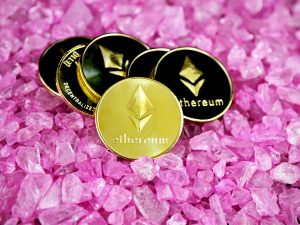We are in the midst of a blockchain revolution and Ethereum is one of its most prominent figures.
Ethereum is introducing another layer of complexity to the blockchain ecosystem and they are shaking things up with the introduction of smart contracts. If you want to learn more about Ethereum, read this book summary.
The book “Ethereum: Blockchain, Digital Assets, Smart Contracts, Decentralized Autonomous Organizations” by Henning Diedrich provides an overview of how this technology works, as well as what it can do for you and your business.
It gives you a clear understanding of Ethereum’s benefits and limitations through practical examples that make sense to anyone who has no previous knowledge of blockchain or cryptocurrencies.
The book chapters cover topics like:
- What are blockchains?
- How do they work and why are they so secure?
- How do smart contracts work?
- What makes them so useful?
- What can you build on top of a chain?
Welcome To The Next Generation of Money
In the early days of cryptocurrency, there was a lot of experimentation. One of the most interesting early attempts at creating digital money was b-money, created by an individual with the online handle “Wei Dai.”
Interestingly, b-money’s transaction log worked in a similar way to bitcoin’s, so every payment was posted for all to see and approve or dispute. Unlike bitcoin, b-money had no decentralized account maintenance system when it first launched. This led to some issues that were solved by Satoshi Nakamoto when he created bitcoin.
The idea of a decentralized digital currency has been around for decades. In 1993, Stuart Haber and W. Scott Stornetta published a book called “A Cypherpunk’s Manifesto.” In it, they described the idea that led to the world’s first blockchain-based cryptocurrency: bitcoin.
In 2008, Bitcoin emerged as the world’s first decentralized digital currency. This was a significant moment in history because it gave people a way to exchange value without having to trust any central authority.
The Superior Alternative To Bitcoin
Just like any other crypto project, Ethereum has had its fair share of ups and downs since its inception back in 2013.
However, the project has always been about more than just creating a cryptocurrency: it’s about empowering people through decentralization by offering them an alternative way to interact with each other without relying on intermediaries such as banks or governments (though they do have their own role).
So while most people associate Ethereum with trading cryptocurrencies like Ether (the token used on this network), what you may not know is that there are many different ways that blockchain technology can be used today—and some of them might surprise even seasoned investors!

Ethereum – History And Current Uses
As a part of my research into blockchain technology, I have been looking at the Ethereum platform and its applications. The book “Ethereum: Blockchains, Digital Assets, Smart Contracts, Decentralized Autonomous Organizations” by Henning Diedrich has given me a good overview of the history of blockchain technology as well as its current use cases.
“Ethereum is by far the most advanced and robust blockchain available. […] Ethereum is the blockchain. A moving target for all who play catchup, with a prodigy founder, hedge fund money as a safety net and a head start of two years.”
Henning Diedrich

The book explains that smart contracts are computer programs that facilitate, verify, execute and enforce contractual clauses between parties involved in an agreement that may include financial transactions like money transfers or payments; Smart contracts are executed automatically when triggered by specific conditions, ensuring fast processing times while being immune from tampering by third parties like governments or corporations down the road where your code may no longer function exactly as it used to.
As an open-source software platform based on blockchain technology, Ethereum enables developers to build decentralized applications (DApps). DApps refer to any application that runs without a central authority, such as banks or any government agency—in this case, you could think of them as apps without middlemen involved.
Ethereum itself doesn’t run these applications; instead, its users create their own DApps using its programming language Solidity and then deploy their specific smart contracts onto Ethereum’s blockchain network where they exist autonomously and cannot be changed once deployed unless certain conditions are met (e.g., pre-defined rules set forth by their creators).
The best way to understand Ethereum is by seeing it as a computer, with the network itself acting like hardware. Ethereum takes this concept one step further, by allowing users to run programs on the network rather than just mine cryptocurrency (as Bitcoin does).
These programs can be used for everything from creating digital assets and smart contracts, to managing decentralized autonomous organizations (DAOs).
To understand what Ethereum is, we need to first understand how blockchains work.
But What Is A Blockchain?
At its most basic level, a blockchain is a distributed ledger that records transactions and other data in a way that cannot be altered once it has been recorded. This means that no one person or entity controls the data or changes it; rather, it is available to all users at once.

“Blockchains add the dimension of trust to data.”
Henning Diedrich
Blockchain technology can be used for many different purposes, such as tracking ownership or recording events in an immutable manner.
Blockchains operate through a consensus protocol known as proof-of-work (PoW) which requires all participants in the network to agree on one “true” version of events that have transpired over time. This means all participants must come up with an identical solution if they want their transactions processed by other peers on the network.
“The convention is that this heaviest chain is always the chain that reflects ‘the truth’ of the world state. All ‘lighter’ chains – concretely, those with fewer blocks, maybe just one less, and a different last block with different transactions or maybe only a different transaction order – are to be rejected.”
Henning Diedrich
The genius of this system lies in the fact that multiple copies of the ledger are held by different parties – all of whom must agree on any changes before they can be made public (or “verified”). This means that if any one party tries to change or manipulate information on their own copy, then everyone else will know about it immediately – because their copies will not match up anymore!
Blockchain is a distributed database that maintains immutable records of transactions. The data in a blockchain is not stored in one place, but rather on every computer (or node) that participates in the network. This makes it very secure: no single entity can affect the information stored on it, since all copies of the blockchain are identical and constantly synchronized with each other.
Spotting The Blockchain Opportunities
Blockchains are not a technology, they’re the result of a number of technologies working together. Just like any other technology, blockchains have their limitations and their own strengths and weaknesses.
As with any other new technology, this new way of thinking will require learning and adaptation on our part.
Blockchain Is Not Bitcoin
We can compare blockchain to the internet in terms of how much it has changed our world: we now use it for everything from ordering food to catching up with friends via video calls or checking into our next flight online; but at first we had no idea what it would become or if we would even use it ourselves.
The same goes for blockchain: while you may hear that this new technology is going to revolutionize everything from banking systems to voting methods—it could well do so someday—it’s important not to get caught up in all the hype right now!
There are still plenty of questions about how exactly these systems will work in practice (including whether they’re actually secure enough or scalable enough), though many people are excited about what might be possible once these issues have been resolved.
About the Author
Henning Diedrich is a blockchain expert and former journalist. He works for IBM and is working on Ethereum-related topics. He has also written an insightful book called “Lexon: Digital Contracts.”
Diedrich does a good job of explaining all of the terminology in plain English and breaking down concepts into easily understood pieces for the reader.
Key Takeaway …
The Ethereum ecosystem is still young, and we are in the early stages of understanding how blockchain technology can be applied to everyday use cases. It’s exciting to see this technology mature and evolve as it enters our day-to-day lives.
You should definitely read this book if you are interested in blockchain technology.

Ethereum: Blockchains, Digital Assets, Smart Contracts, Decentralized Autonomous Organizations: Summary, Chapters, Features, Benefits & Pricing of Henning Diedrich’s Book
We are in the midst of a blockchain revolution and Ethereum is one of its most prominent figures. Ethereum is introducing another layer of complexity

Blockchain Revolution: Summary, Chapters, Features, Benefits & Pricing of Don & Alex Tapscott’s Book
The book makes it clear that although there are many uses for blockchain technology today (mostly in cryptocurrency), there are even more exciting possibilities for its use in tomorrow’s world – especially if you’re an entrepreneur looking at new ways to disrupt existing industries!

The Age of Cryptocurrency: Summary, Chapters, Features, Benefits & Pricing of Paul Vigna and Michael J. Casey’s Book
The Age of Cryptocurrency: A Beginner’s Guide to Investing in Bitcoin and Other Cryptocurrencies is a timely book: from the growing interest in Bitcoin and

Digital Gold: The Untold Story Of Bitcoin – Summary, Chapters, Features, Benefits & Pricing of Nathaniel Popper’s Book
Nathaniel Popper’s book is a deep dive into the history of Bitcoin, from its early days as an experiment in digital cash all the way up to the present day, when crypto tokens have taken over the imaginations of technologists everywhere.

The Promise of Bitcoin: A New World Of Unsecured Money – Summary, Chapters, Features, Benefits & Pricing of Bobby C. Lee’s Book
Explore the potential of unsecured currency with “The Promise of Bitcoin” by Bobby C. Lee. Our review offers insights into Lee’s groundbreaking book. Join the Bitcoin revolution and discover the future of money.

Cryptoassets: The Innovative Investor’s Guide To Crypto And Beyond – Summary, Chapters, Features, Benefits & Pricing of Chris Burniske & Jack Tatar’s Book
Burniske & Tatar explain that cryptoassets represent a new asset class that has yet to be fully understood by most investors. They offer definitions for all kinds of cryptoassets. If you’re looking to take your cryptocurrency knowledge to the next level, this book is an excellent place to start.
Author
-
CEO and Co-Founder at AmpiFire. Book a call with the team by clicking the link below.
Related Posts

Blockchain Revolution: Summary, Chapters, Features, Benefits & Pricing of Don & Alex Tapscott’s Book
The book makes it clear that although there are many uses for blockchain technology today (mostly in cryptocurrency), there are…

Digital Gold: The Untold Story Of Bitcoin – Summary, Chapters, Features, Benefits & Pricing of Nathaniel Popper’s Book
Nathaniel Popper's book is a deep dive into the history of Bitcoin, from its early days as an experiment in…

The Age of Cryptocurrency: Summary, Chapters, Features, Benefits & Pricing of Paul Vigna and Michael J. Casey’s Book
The Age of Cryptocurrency: A Beginner's Guide to Investing in Bitcoin and Other Cryptocurrencies is a timely book: from the…

Cryptoassets: The Innovative Investor’s Guide To Crypto And Beyond – Summary, Chapters, Features, Benefits & Pricing of Chris Burniske & Jack Tatar’s Book
Burniske & Tatar explain that cryptoassets represent a new asset class that has yet to be fully understood by most…

The Promise of Bitcoin: A New World Of Unsecured Money – Summary, Chapters, Features, Benefits & Pricing of Bobby C. Lee’s Book
Explore the potential of unsecured currency with "The Promise of Bitcoin" by Bobby C. Lee. Our review offers insights into…

Crypto Wars: Faked Deaths, Missing Billions and Industry Disruption – Summary, Chapters, Features, Benefits & Pricing of Erica Stanford’s Book
In this book, you will learn how to spot some of the biggest red flags in the cryptosphere and get…










